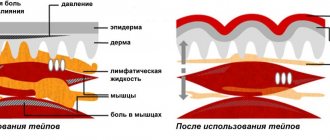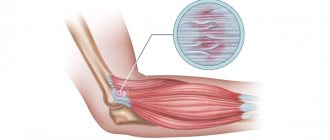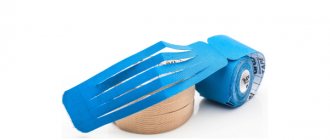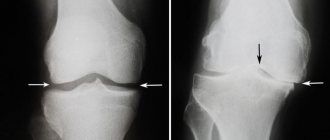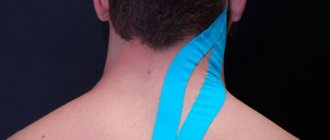We take freedom of movement and life without pain for granted. Running from a traffic light to the bus, walking to the store, playing tag with your child is an everyday routine! Exactly until the moment problems arise in the knee joints: stiffness of movement, pain, sprains and torn ligaments.
No one is immune from injuries, especially if they engage in extreme sports or lead an active lifestyle. People who are overweight and those who spend a lot of time on their feet while working also risk the health of their knee joints. In addition, most older people experience age-related changes in their knees.
Both medicinal and non-medicinal methods of combating knee pain are used. Among the popular non-invasive ones is kinesio taping. The method was developed in 1973 by Japanese-American doctor Kenzo Kase and underwent clinical trials. It has shown effectiveness both when used alone and in tandem with other methods of relieving joint pain. Kinesio taping is used not only by doctors and cosmetologists, but also by athletes. The method became widespread after the 1988 Seoul Olympics. Then Olympians with ribbons on their bodies appeared on TV screens around the world.
The taping technique involves applying applications of elastic patches on a fabric basis to the skin according to specially developed patterns.
Tapes help:
- relieve pain syndrome;
- reduce swelling in the fixation area;
- stimulate muscle tone.
Thanks to the sensory, vascular and muscular mechanism of operation, taping has a complex effect on the area of application.
- The adhesive base of the tape helps to fix it in a given position. So the patch works depending on the taping technique: both as support, and as a stimulator of muscle tone, and as a limiter of joint mobility.
- The tape is made of hypoallergenic eco-friendly materials: cotton, nylon, artificial silk.
- The fabric base is woven in such a way that its thickness and elasticity replicate the properties of human skin.
- The tape is breathable and securely fixed on the body. This allows you to wear the application for up to 5 days, play sports with it and take a shower.
- Taping is not felt on the skin or noticeable under clothing, but it helps muscles work more intensely, relieves joints and stimulates metabolic processes.
- A correctly fixed patch has a massage effect, stimulates blood flow and helps with lymphostasis.
- It also relieves swelling and inflammation caused, for example, by damage to the anterior cruciate ligament.
- Kinesio taping performed according to the rules can also help with pain in the knee joint, sprained tendons and stiffness of movement during stretching.
Effects of using tapes
Knee taping for sprains is a modern method of physical therapy. The effectiveness of taping for various pathologies has been experimentally proven. Doctors in many countries actively use tapes to restore patients’ mobility. Kinesio tapes are universal and indispensable in the treatment of joint and muscle diseases.
They have the following effects:
- anesthetize the desired area (including when ligaments are torn);
- improve blood circulation and the quality of lymph flow;
- help accelerate metabolic processes in tissues;
- relieve and prevent inflammation;
- limit the range of movement of the damaged area;
- have the effect of a light massage, due to which the muscle fibers become toned.
Kinesiological elastic bandages contain no active substances that can enter into a chemical reaction with other compounds in the body. Thanks to this, when sticking kinesio tape, you can take standard medications. Kinesio tape has a local effect. This makes it possible to accurately monitor the effectiveness of its use. If the use of a patch does not improve the condition, you need to make sure that the bandages are applied correctly.
Only a well-applied tape on the knee can help cope with the disease.
BBTape brand tapes are made from natural materials. They do not cause allergies, are easy to stick on and can be removed painlessly. Such kinesio tapes can be used by both children and elderly people. There are several types of BBTape tapes that are recommended for knee treatment.
| NAME | PECULIARITIES |
| BBTape Max with reinforced adhesive | Kinesio tapes are designed specifically for professional athletes, can withstand significant loads and do not require replacement within 7 days. |
| BBTape Lite with soft glue | Tapes are designed for people with sensitive skin and are often used in young children and in cosmetology for taping the face and neck. |
| BBTape Ice | These tapes have a silk base, so they are not felt when worn for a long time and cause a slight feeling of coolness. |
Tape or knee brace, comparison
Tapes are used in the correction of diseases of the musculoskeletal system - for knee bruises, bursitis of the knee joint and other diseases and injuries. Kinesio tapes perform the functions of an elastic bandage, reliably fixing the damaged area, promoting its speedy healing and preventing negative consequences in the form of repeated damage, etc. Lymphatic drainage taping is an alternative to using a knee brace, which acts locally, immobilizing a specific area, taking into account the anatomical characteristics of a particular patient.
The knee brace is a bandage without fasteners, which is quite difficult to put on over the foot. As a rule, it is made of fabric that does not allow air to pass through well. An error in size when choosing a knee pad can reduce the effectiveness of its use to zero. Despite the fact that tapes have obvious advantages, when choosing between a knee brace and them, it is better to consult a doctor. Athletes often prefer to wear knee pads during training, and use tapes during competitions.
When is knee taping necessary?
Kinesio tapes are applied to the knee in a variety of cases. They are necessary to prevent re-injury if chronic or fatigue injuries have been recorded. Athletes apply kinesio tape to their knee joints before competitions, since increased stress can cause chronic injury.
Kinesio tapes are used during the period of convalescence for injuries and all kinds of diseases that are accompanied by pathological damage to the knee. Such diseases include arthrosis, gout, rheumatoid arthritis, etc. Before the first procedure, you should consult a doctor, because... For some diseases of the knee joint, taping is ineffective.
Tapes are indispensable during the rehabilitation period for meniscus tears, posterior cruciate ligament sprains, dislocations and strong impacts. They are needed when inflammatory processes occur in the tendons, bursitis and damage to the cruciate ligaments of the knee. Kinesio patches are also used for gonarthrosis - decreased mobility of the knee joint.
What effect is achieved
There are a variety of types of procedures:
- Therapeutic kinesiotaping of the knee joint. Its goal is to provide stability and stability to the affected area to reduce swelling, pain and inflammation, and prevent the development of negative consequences;
- Functional. Conducted by athletes before training and competitions to prevent injuries and damage, improve the functioning of muscles and other tissues;
- Rehabilitation. The knee joint is stabilized, the patient’s condition and well-being improve, and recovery occurs faster and without possible unwanted deviations.
Classic rules for using tapes
When purchasing tape, you need to check the integrity of the packaging and also study the composition of the tape. To treat any joint pathologies, you need to use tapes made of high-quality materials, because... only they can provide the desired therapeutic effect. Low-quality kinesio tapes will not attach well and can quickly come off. Before the procedure, the skin at the site where the tape is applied should be degreased. Also, this area of the skin must be carefully palpated.
Kinesiology elastic patch is usually glued along the muscle axis. It should not pinch the lymph nodes and major blood vessels. In this case, the kneecap remains free. The degree of tape tension is determined by the patient’s pathology. For a strong adhesion, after gluing the kinesio tape, it should be carefully smoothed. These tapes contain thermoactive adhesive, which is activated after reaching a certain temperature.
How often to change the tape when taping a knee
According to the recommendations of experts, the tape should be worn no longer than 4-6 days, then it should be replaced. This period may vary individually, in particular, until the patch comes off on its own or until the pain subsides. On the leg, the tape may come off faster than, for example, on the back. In order to reduce the likelihood of peeling off, you can sprinkle the surface of the tape with talcum powder after fixing it. This way the tape will definitely not stick to clothes.
Important! Before removing the tape, you need to wet it or moisten it with cream. In this case, removal should be carried out in the direction of hair growth.
There are no special rules regarding pauses between tape applications. You can take a short break of one or a couple of days to “rest” the skin. However, it is allowed to wear tapes for a longer time, changing them periodically, until symptoms disappear completely or are cured. The main thing is to do this under the supervision of a specialist.
Effective taping techniques
Today there are 3 main methods of taping a damaged knee.
The functional method is used by athletes to prevent injuries. It helps reduce pressure on the muscles and ligaments of the knee joint. In this case, adhesive tape is applied daily before training to prevent injury to the ligament.
The therapeutic method is used to treat various injuries. It allows you to quickly restore the performance and functionality of the knee joint. Correctly applied kinesiology adhesive tapes reduce the load on the sore knee. Rehabilitation taping is the most complex method. Taping the ligaments of the knee joint affects lymph flow, relaxes muscles, relieves swelling of tissues and relieves pain.
There are quite a lot of techniques for applying tapes. Before the procedure, you need to choose a method and use it in accordance with the doctor’s recommendations. It must be remembered that incorrectly applied kinesio tape can lead to complications.
Taping of knee ligaments
Three types of ligaments are involved in the functioning of the knee joint: lateral, posterior and intra-articular. More often than others, those located inside the joint are injured: the cruciate and transverse ligaments. However, strong external ligaments also need support. Kinesio tapes for the knee will help provide preventive effects and improve the condition of the ligaments. Apply the tape according to an easy-to-follow pattern to:
- avoid injury and reduce the load when standing,
- facilitate recovery after fitness activities,
- do not worry about the health of your knees on a hiking trip.
Kinesio taping for arthrosis of the knee joint
Slow inflammation and pain caused by arthrosis can be relieved by taping the internal and external ligaments of the knee. The patch is applied directly to the muscles surrounding the joint. It will help relieve their tension. The patient lies down on the couch with his knee bent at a right angle. The doctor cuts the kinesiology tape 25 cm long and rounds the corners. Then this tape is cut in half lengthwise, leaving a piece of approximately 5 cm long uncut on one side. The shape of the patch will resemble the letter Y.
The base of the tape should be secured to the tibial tuberosity below the knee. Then the tails of the tape are glued upward from the base with minimal tension on the outer and inner surfaces of the knee. As a result of these manipulations, the kneecap is well fixed with the tails of the patch.
Then you need to cut 2 kinesio tapes 15 cm long. One of them is glued across the base of the already applied tape. First, the central part of the tape is attached with minimal tension, and then anchors are applied without tension on the lateral and medial sides. The second patch is glued in a similar way, but above the knee, and the middle of the kinesio tape is located on the thigh. In case of severe swelling, you can use the method of lymphatic correction by applying parts of the tape to the area of edema.
The main causes of arthritis
Due to the cause of its occurrence, this disease is divided into three categories - arthrosis, rheumatoid and post-traumatic arthritis - and taping is performed in the same way in each case, regardless of the source of the problem. Arthrosis is a disease based on the wear and tear of cartilage tissue. Application of tapes in this situation provokes minimal load on the damaged area. That is, applying tape is recommended for people of retirement age to prevent the formation of arthritis.
Rheumatoid arthritis occurs at any age and affects both joints. The basis is the inflammatory process, when in the process of destroying microbes the body begins to attack its own tissues, and this is most often the tissues of the joints, therefore, with such arthrosis, not only drug treatment is performed, but also taping.
Post-traumatic arthritis occurs due to injuries, so tapes are used by athletes during any training to prevent the occurrence of serious injuries that could become the basis for arthritis.
Before using the method, it is recommended to study a video on how to tap a knee , as well as view various diagrams that could help you get the optimal result.
Kinesiological taping of the meniscus
Kinesio taping is indicated for any damage to the meniscus: bruise, tear, or rupture. But before using tape, you need to consult a doctor. During the postoperative period, the use of kinesio elastic cotton patches is possible only as prescribed by a doctor.
To carry out the procedure, you need to take one Y-shaped kinesio tape about 25 cm long. Its anchor is glued under the patella, and the tails are fixed near the kneecap with an overlap. Then take two 15 cm long patches and apply them to the lateral ligaments of the knee. The degree of tension of the bands depends on the nature of the injury.
Types of meniscal tears
In orthopedics, the following types of meniscal tears are distinguished:
- rupture at the attachment point,
- rupture with preservation of the capsule,
- patchwork gap.
If the fixation of the meniscus to the bone is disturbed, it is possible to restore the integrity of the cartilaginous tissue by limiting the mobility of the joint and protecting against repeated bruises and damage. In the other two cases, treatment requires surgery.
Rupture of the meniscus with preservation of the capsule is divided into several types:
- oblique,
- longitudinal,
- radial,
- horizontal,
- combined,
- transverse, in the middle “basket handle”.
Partial ruptures are treated with conservative methods under the supervision of a physician.
There are several degrees of meniscus damage:
- stage zero - cartilage tissue remains in its normal state;
- the first stage - a focus of increased intensity is noted in the thickness of the cartilage;
- the second stage is a linear focus of increased intensity, which does not extend to the limits of the cartilaginous growth;
- the third stage - the lesion reaches the surface of the cartilage tissue.
An MRI or X-ray can determine the extent of connective tissue damage.
An injured meniscus poses a threat to the entire joint capsule of the knee. With every movement, its irregularities destroy joint tissue. Untimely treatment can cause the development of complications such as arthrosis, arthritis, osteoarthritis and, as a result, complete destruction of the knee and loss of motor ability may occur. Kinesio taping helps prevent the development of severe complications and speeds up rehabilitation after injuries.
Taping the cruciate ligament of the injured knee joint
Most often, knee ligaments are taped for sprains. Taping of the cruciate ligaments occurs with light tension (about 50%). If you overdo the tension of the tape bandages, you can overtighten your knee and impair blood circulation.
First you need to cut 4 small narrow tapes. The first patch is applied above the patella. The tape is placed from the upper outer edge of the knee joint towards its inner lower edge.
Then the next tape is glued under the patella parallel to this patch. The remaining two tapes are glued in a mirror image with respect to the first two. Also, kinesio tapes should be attached under and above the joint to fix the posterior cruciate ligament.
When is it recommended to use taping?
Taping of the knee joint and ligaments is performed in the following situations:
- When treatment for various acute injuries (dislocation or sprain). For damaged ligaments. For arthritis, inflammatory joint lesions, arthrosis, this technique is used for an optimal therapeutic effect;
- As an element in the prevention of re-injury. For example, if a person injured his kneecap, received treatment, but his work requires significant stress on his legs. If there has been a tendon strain or other sports injuries, tapes are applied to eliminate negative manifestations in the form of pain and to prevent new injuries.
In sports, taping is the optimal solution for fixing the knee joint. Since taping the kneecaps promotes proper load distribution. Protection of the lateral ligaments is formed, which eliminates serious sports injuries.
Taping the lateral ligament for sprains
Taping the medial collateral ligament of the knee begins with preparing three strips of approximately the same length. The patient should lie on the couch and slightly bend his knee. The base of the first tape should be glued to the tibial tuberosity, and its ends should be attached to the sides of the kneecap.
The remaining two kinesio adhesive patches are applied from the kneecap to the quadriceps muscle. In this case, the anchors of the tape bandages should not cross. It is this taping of the lateral ligament of the knee joint that helps get rid of sprains.
Application in sports
Run
Runners experience many different types of injuries, but the most common pain they experience is on the outside of the knee. However, people who walk, ski and bike can also experience similar problems. Taping the knee for pain on the side requires applying the longest adhesive tape to the outer side of the thigh. The lower end is fixed to the area just below the knee, and the second extends all the way to the pelvis. The second tape should be fixed perpendicularly. Correctly attaching the tape to the knee is the key to success and prevention of new injuries.
Jumping
To achieve good results in sports, jumpers are required to endure extreme loads. Athletes have to train a lot and intensively, which can be fraught with rupture of Baker's cyst and other injuries that require high-quality and timely correction.
Taping the knee in case of injury is carried out by applying a certain application, which uses two pieces of tape. Their length is equal to the distance from the area under the kneecap to the lower third of the thigh. Measurements must be taken in a position in which the leg is bent at a right angle. Each of the tapes must be fixed around the knee without tension so that the ends intersect each other.
Struggle
Taping the knee ligaments among professional wrestlers is a fairly common practice. Most often, elastic bands are applied to “working tools” - knees, hands and fingers. If such a need arises, a technique similar to taping a runner's knee is used. If the strip is glued in the direction of muscle contraction, this has a tonic effect, allowing a greater number of muscle fibers to be involved in the work. If kinesio tape is fixed at the site of muscle attachment and stretched to its beginning, this allows you to achieve a relaxation effect, and the number of muscle fibers involved in the work decreases.
Team sports
Taping the hamstring is a common practice when playing team sports. In both team and individual games, athletes run and jump, so any technique applicable to the knee of a jumper or runner will be relevant. By fixing the tape in the right place, you can both limit and enhance the mobility of the joint and muscles, facilitate their work, set tone and adjust the degree of mobility of various segments of the body.
Contraindications for wearing tapes
Contraindications to taping of diseased joints can be absolute or relative.
The first category includes malignant tumors, pre-stroke conditions, open wounds in the popliteal region, thrombophlebitis and severe neurological and mental illnesses. If they are present in the patient, taping the knee ligaments can lead to an exacerbation of the disease (for example, the spread of metastases).
There are more relative contraindications, but they allow the application of kinesio tapes, albeit with some restrictions. These include benign neoplasms, cardiac and kidney pathologies, diabetes mellitus, skin diseases at the site where the tape is applied, as well as individual intolerance to the components of the tape. In this case, the safety of taping should be assessed by a doctor. If after applying kinesio tape the patient feels pain, tingling or heaviness in the knee, then the tape should be removed. But the likelihood of side effects during taping is minimal.
Kinesio tape: a modern treatment method
In addition to drug treatment for meniscal injuries, it is recommended to use taping as a new but very effective method of treatment.
The essence of the technique is the use of elastic - specialized tapes that prevent sprains, relieve pain, and restore normal blood circulation. Kinesio taping of the knee joint involves applying tape to a clearly defined area, which will prevent the occurrence of mobility and guarantee the desired effect. Taping of the knee joint is carried out in a special way; you need to first watch the video, study the information, and consult a doctor. In the future, the process of applying tapes can be carried out independently:
Why you should use the taping technique:
- By correctly applying the tape, conditions are created to relieve inflammation and eliminate pain;
- If taping is performed correctly, the movement of lymph improves and conditions for normalizing blood flow arise;
- The pressure on the ligaments is reduced (injury to the meniscus requires restoration of all surrounding tissues).
Application of tapes - stabilization of the joint and, in the future, restoration of its function. Since the tape stays well on the knee, it is performed once and for several days.
Conclusion
Fixing the knee with tape is an effective way to treat various pathologies of the knee joints. Taping the internal and external collateral ligaments of the knee allows for faster recovery even after serious injuries. Modern kinesio tapes made from natural cotton are unique in that they can be used to treat small children, the elderly and nursing mothers
SUBSCRIBE TO OUR CHANNEL OF THE INTERNATIONAL TRAINING CENTER BBTAPE ON YOUTUBE AND LEARN ALL THE SECRETS OF TAPING FROM FIRST HANDS!
Recommended Articles
Taping the external collateral ligament of the knee Fixation of the knee joints is required for various injuries. Taping of the knee joints is a completely new method of exposure, which makes it possible to achieve high efficiency. With such fixation of the lateral ligament of the knee joint, a targeted effect is provoked on the area of injury. The movement of the joint itself is not limited
Running patch Playing sports carries certain health risks. Running was no exception. Sprains, ankle pain, foot injuries, muscle tears, hamstring injuries and other troubles disrupt the usual pace of training and, in general, negatively affect overall results.
Taping of the hip joint Many pathologies of the hip joints can be solved with the help of kinesio taping. This treatment method involves the application of special cotton elastic bands or tapes. Timely taping of the hip joint ensures its functional restoration even in case of severe damage. Kinesio taping for coxarthrosis and arthrosis is used in the world's leading rehabilitation clinics
What injuries require knee taping?
Unlike plaster or bandage, tape does not restrict movement; it exactly follows the natural shape of the body, making its presence easy to hide under clothing.
In some cases, tape can lead to the opposite effect - worsening the condition. Therefore, it is better to tape after consultation with a doctor. In particular, tape should be applied to the knee when:
- Bruises
- Pain
- Chronic diseases, such as arthrosis
- Meniscus damage
- Sprained muscle fibers and ligaments
- Cruciate ligament rupture
For bruise or hematoma
This injury is accompanied by intense pain and muscle weakening.
You can use a wide (10 cm) tape, cut into 5 parts, leaving the anchor intact.
Algorithm of actions:
- Leave 5 cm on the anchor area, which should be fixed slightly above the swelling area, with the ends of the tapes directed towards the affected area.
- Apply the tape to the injured area without tension.
- Apply another cut tape crosswise relative to the first tape.
Kinesio taping of the knee joint in this case has a drainage effect, ensuring the removal of decay products along with lymph. As a result, swelling and cyanosis of the tissues are reduced.
Important! Tapes are not sterile, so they cannot be used on open wounds or damaged areas of skin.
Video:
If you have pain
- Apply one single strip of tape slightly below the kneecap. Position it perpendicular to the axis of the limb.
- Then apply two tapes in a cross pattern above and below the patella area.
- Next, apply several strips on top of the pasted tapes for final fixation.
This will strengthen the external and internal ligaments, as well as reduce the load on the joints and muscles. As a result, this will lead to a decrease in the intensity of pain, as well as acceleration of regenerative processes.
Video:
For arthrosis
In the case of arthrosis, the first task of taping is to reduce the intensity of pain. This can be achieved by reducing the degree of tension in the periarticular muscles, so it is necessary to fix the tapes on them.
You need to use a wide Y-type tape (split end). In this case, the tension should be about 40%. If tissue swelling is observed, lymph tape should be used, directing its rays to the area of the lymph nodes.
The application is performed as follows:
- Apply the tape at the level of the kneecap at a distance of 10-15 cm from the knee joint.
- Place the tapes on both sides of the knee pad area, wrap the ends under this area. This allows you to fix the ligaments as securely as possible.
- You can also apply more tape horizontally just below the knee joint, as well as apply single-strip tapes to the area of the tendons attached to the knee joint. This will relieve pain and make movement easier.
For meniscus injury
In this case, tapes can be used during rehabilitation or during treatment. Applications reduce the risk of further cartilage destruction.
To tape the knee in this case, you need to use a Y-type tape. Followed by:
- Apply the edge of the tape under the kneecap area. Place the ends around this area and direct the rays upward.
- Fix nearby ligaments, placing the tapes according to the direction of growth of their fibers.
This technique allows you to speed up the recovery process and provides ease of movement.
Video of applying tape for a meniscus injury:
For knee sprains
Regardless of which area is damaged - external or internal, the entire knee needs reliable fixation.
To do this you need:
- Place single-strip tapes horizontally above and below the joint at a distance of 10-15 centimeters, with their anchors located at the back.
- Next, stick one end of the tape on the outside in the area of the upper edge of the knee, and fix the other in the lower corner of the inside, placing it diagonally. Thus, the tape covers the area above and below the knee pad.
- Do the same thing, only fix the end of the tape in the upper corner of the inner side and bring it to the outer outer part of the popliteal region.
- Finally, we glue additional tapes on top to secure above and below the knee area perpendicular to the limb.
In this case, you should not create tension, which in this case can lead to ischemia (the maximum allowable is 25-30% if it is necessary to stabilize the joint). The elastic properties of such tapes are quite sufficient for fixing injured ligaments.
This taping of the knee joint makes it possible to maintain its mobility without the risk of complications from the injury.
In case of injury to the lateral ligament
The purpose of applying tape in this case is to relieve the ligament. You need to take two strips 5 cm wide and 20 cm long. Next you need to:
- Bend your knee at an angle of 90 degrees.
- Fix the anchor of the first tape above the middle of the shin, and secure its end above the area of the kneecap, closer to the outer part of the thigh.
- The second tape needs to be fixed under the kneecap, and its base should be glued to the area of the internal collateral ligament of the knee. Secure the end in the middle of the outer thigh.
Video of applying tape to the medial collateral ligament of the knee:
In case of damage to the anterior cruciate ligament
For this type of injury, tapes are often used during rehabilitation. This will allow the limb to regain its previous strength and mobility.
Application method:
- Round off the ends of the tape.
- Bend your knee at an angle of 70 degrees.
- Fix the anchor under the knee from the inside towards the outer kneecap, repeating the location of the cruciate ligament.
Video of applying tape for anterior cruciate ligament injury:
It must be remembered that tapes provide only superficial fixation of muscles and ligaments, so they can only be used as an auxiliary treatment method or a means of preventing the disease.
Cost of treatment
Today, the taping market is represented by many companies, the most popular of which are Spider Tech, Kinesio, Apec. All brands have a line of budget and expensive products. Budget tapes are available in rolls (from 200 rubles per roll of 5 m). The disadvantage of these tapes is that it is difficult to choose the right shape. Only a teipiatrist can cut the required length, whose services must be paid for (about 1,500 rubles).
There are medium-cost I- and Y-shaped cutting strips. Any person can handle these products, but the length of these tapes may not always be suitable.
There are also ready-made piece tapes for a specific area of the lesion. These tapes are the most expensive (from 150 rubles per unit), but with the help of instructions they are the easiest to deal with.
It is necessary to take into account that the cost of taping depends on the cost of the tape and on the level of the clinic where the specialist works. Many gyms have trainers who are certified in taping, and this is included in the cost of a personal training session.
Symptoms of the disease
Symptoms usually appear immediately after injury.
Damage is often accompanied by the following symptoms:
- limitation of mobility,
- painful sensations,
- clicks and crunching when flexing/extending,
- swelling of soft tissues,
- fatigue after physical activity,
- joint stiffness, especially in the morning.
Diagnosis is carried out taking into account the mechanism of injury and data obtained during the examination. The more pronounced the clinical signs, the more significantly the ligamentous fibers are damaged. Swelling and hemorrhage may increase over time. With very fresh injuries, the symptoms may be less pronounced than with injuries that were 2-3 days old. To make a diagnosis, an MRI or ultrasound of the knee joint is prescribed.
Tapes are a loose concept
In the 70s of the last century, Kenzo Kase, an American of Japanese descent, discovered that the hands of a therapist, acting on the skin in a certain way, could relieve painful sensations in the patient’s body. Using rigid tapes coated with glue, he tried to achieve the same effect.
In 1973, the doctor created an elastic patch, which was later called “kinesio tape.” Another fifteen years of detailed development of the method and its popularization passed - and the whole world became seriously interested in the capabilities of tapes, having seen them on the athletic bodies of athletes at the 1988 Olympics in Seoul. And who could resist such wonderful “advertising media”?
Modern tapes have a hypoallergenic adhesive layer and are easy to apply.
There are tapes of different widths and colors. There are even children's ones - with cute cats.
Models with a reinforced adhesive layer can be used in swimming pools and ponds. Inelastic silk tapes are used, as a rule, to fix joints. Elastic ones stretch either only in length, or in length and width, or, which is rare, only in width.
How it works
There are three ways to apply tape:
- Lymphatic drainage. Like any lymphatic drainage procedure, lymph taping helps remove excess fluid and metabolic products from the intercellular space.
- Taping the muscle to relax prevents the muscles from entering physiological hypertonicity (when they cannot relax at the right time). For example, if, when bending an arm, the extensor is stuck in a tense state and a person cannot perform this movement correctly, the tape will come to the rescue and allow the necessary muscle to relax.
- Muscle fascilization is a stimulating and strengthening muscle seal. If normally you throw the ball only 20 meters, then with the muscle taped for stimulation, you can try to throw it 25 - and surprise everyone with an unexpected result.
Principled approach
If you know the basic principles and understand how and when to use tapes, they can be applied to any part of the body that needs help. Multi-colored strips are useful where you need to speed up the healing of various injuries that are not associated with inflammation on the surface of the skin: dislocations, fractures, bruises, contusions and sprains. If there are abrasions, and even more so, purulent wounds, tape cannot be used - this may threaten the further spread of infection.
Like any active tool, tapes can bring both benefit and harm. Thus, a runner who has taped his knee incorrectly risks ending up in trauma and not finishing the marathon – while correct taping will help him significantly reduce the standard swelling.
Taping: is it sporty?
By the way, about athletes. Recently, there has been a tendency to exclude taped participants from some competitions. This is mainly due to the stimulating function of tapes.
During sports taping, a lot of attention is paid to suffering, injured joints. A lymphatic drainage seal is made for them, a bit like an octopus. The specialist glues these “octopuses” in such a way as to improve lymphatic drainage and relieve swelling that impedes the restoration of the joint. Taping is also used to support the muscle and help the joint. For example, tape can help stabilize a runner's injured knee in the correct plane and help it move naturally, avoiding additional damage.
In beauty networks
It would be strange not to use the lymphatic drainage properties of tapes when there are so many people around who want to reduce their waist size. But this is not all that they are capable of in aesthetic medicine and cosmetology. Lymphatic drainage patches on the face, neck, and collarbones can improve the oval shape, tighten sagging skin, smooth out wrinkles and achieve a fresh complexion.
The facial muscles are also taped to relax. From their constant tension, facial wrinkles are formed, which begin to smooth out if we relax these muscles. You can tape all the facial muscles in a row, allowing them to deeply relax, or you can do this selectively, working with problem areas. So, if a person has a pronounced vertical fold between the eyebrows, those muscles that, when tense, form it, are glued to relax.
The muscles that are located above and below the hyoid bone - those that affect the severity of the double chin - are glued for stimulation.
Should I take tapes into my own hands?
We asked Natalya Tsvetkova, a craniosacral therapist with a two-year diploma from the Institute of Clinical Applied Kinesiology (the only representative in Russia of the international institutes Upledger (USA) and Barral (USA - France)) to talk about the obstacles to taping.
“First of all,” says Natalya, “you need to be guided by the rule “do no harm.” When working with tapes, you need to understand very well what you are doing and why. Without knowing the principles of sealing or using them incorrectly, you can cause or aggravate a painful condition, provoke convulsions, deepen wrinkles, and increase the development of infection. There are individual contraindications to taping that everyone should remember.
Therefore, those who have:
- allergy to glue. Although the adhesive layer of modern tapes has hypoallergenic properties, in extremely rare cases even it can cause allergies. The correct taping protocol includes a preliminary skin sensitivity test;
- any skin damage, especially purulent ones. You may think that a harmless pimple on your chin will not interfere with taping. But we don’t want to get acne all over our face, do we? A competent specialist will definitely retreat at least three centimeters from the source of infection;
- pregnancy. Of course, if a pregnant woman simply hit her elbow, the healing seal is unlikely to harm her. But many experts believe that at this stage of a woman’s life, a regular bandage is much safer than bandage taping;
- oncology. There are restrictions here that also apply to massage and any other effect on the body: in order not to unwittingly accelerate the spread of the disease, you cannot break the barrier built by the body tissues around the tumor;
- kidney problems. Before lymphatic drainage taping, the cause of the swelling must be determined. If the fluid is excreted through diseased kidneys, the latter will receive additional stress. Combining taping with a hemodialysis procedure is not allowed;
- cardiovascular problems. Contraindications to kinesiotherapy are coronary heart disease and carotid artery pathology. There is a danger of atherosclerotic plaque rupture and blockage of blood vessels. Elderly people should remove tapes on time so as not to expose themselves to the risk of a heart attack.
Features of kinesio taping
There are rules that help you apply an appliqué without errors. Here are 4 of them:
- The tapes should be applied to the joint, which is bent at an angle of 90 degrees.
- The tension level should not exceed 50%.
- The edges of the patches must be rounded.
- Before the procedure, you should degrease the skin.
If you follow these simple recommendations, taping of the popliteal ligament and tendon during a sprain will not have to be performed more than once every 5 days.
Target
The McConnell patellar taping technique was developed to correct patellofemoral kinematics and allow patients to participate in activities of daily living and perform therapeutic exercises without pain. Although several taping techniques exist depending on the specific needs of the patient (eg, glide, tilt, and/or rotation), virtually all patients require medial patellar glide.
McConnell taping is performed by applying rigid tape across the anterior aspect of the patella, which moves the patella medially to place the patellofemoral joint in a more correct midline position. Once the tape is applied, patients should experience a reduction in symptoms, allowing them to perform therapeutic exercises without pain. Therefore, the ability of the tape to maintain the midline position of the patella is critical to the quality and duration of physical activity.
Correction of the position of the patella
There are three most common radiographic measurements of patellar alignment: angle of congruence (AC), lateral patellofemoral angle (LPA), and lateral patellar displacement (LPA). UC shows lateral glide and tilt, LPU shows lateral tilt, and LSN determines the position of the patella in the frontal plane relative to the medial femoral condyle in millimeters.
Several studies have provided evidence that medial taping can show a change in patellar position on radiographs in patients with PFPS (significant change in LPU and LSN). The researchers suggest that this may be enough to create a small change in intra-articular or intraosseous pressure. Thus, McConnell taping can influence the position of the patella (according to changes in the LPU and LSN). The benefit of taping in relation to the UK has not been proven.
Overlay Methods
The creators of kinesiology have developed ready-made schemes that allow you to carry out the procedure at home, without going to the hospital. But only if there are no serious injuries, the following techniques should be used:
- Ligamentous. Taping the medial ligament of the knee for a sprain can be done using two I-shaped tapes.
- Lymphatic. The patch is cut into a fan shape, then strips are glued to areas of intense drainage.
- Muscular. The applications are fixed along the lines of the ligaments. Problem areas are supplemented with compression sections.
If it is necessary to tap the back of the knee when it is sprained, a ligament technique is used. The tension of the tape should not be more than half the distance.
